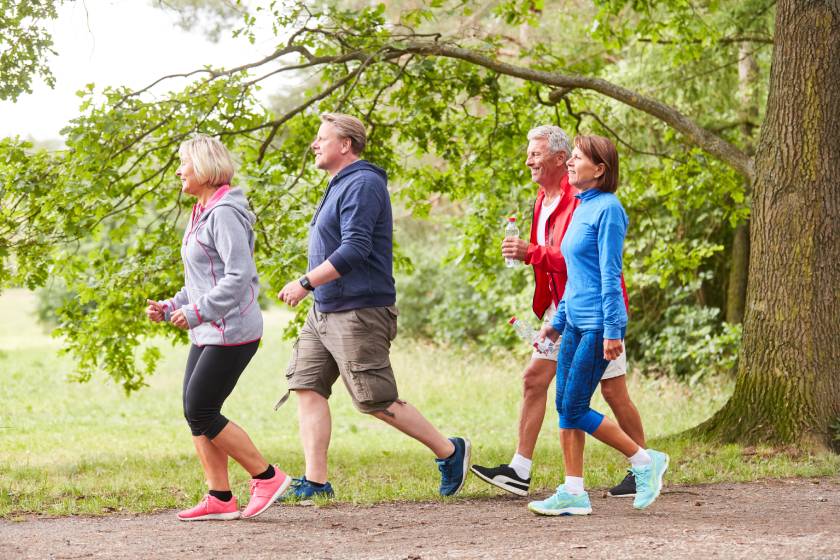
Walking is a simple, accessible, and highly effective form of physical activity that offers numerous benefits for both weight loss and overall health. Here's a breakdown of how it contributes:
How Walking Contributes to Weight Loss:
- Calorie Burning: Walking burns calories, which is fundamental to weight loss. To lose weight, you need to create a calorie deficit, meaning you burn more calories than you consume. Regular walking helps achieve this by increasing your daily energy expenditure. The number of calories burned depends on factors like your weight, walking speed, duration, and terrain (walking uphill burns more).
- Reduces Body Fat, Including Belly Fat: Studies show that consistent walking, especially brisk walking, can help reduce overall body fat, including stubborn belly fat (visceral fat), which is linked to increased risks of heart disease and type 2 diabetes.
- Preserves Lean Muscle Mass: When you lose weight, especially through diet alone, you can lose both fat and muscle. Walking, as an aerobic exercise, helps preserve lean muscle mass. This is crucial because muscle is more metabolically active than fat, meaning it burns more calories even at rest, supporting a healthy metabolism and making weight maintenance easier in the long run.
- Supports Weight Maintenance: Many people regain weight after losing it. Regular physical activity, like walking, is a proven strategy for maintaining weight loss long-term. It helps counteract the biological changes that can lead to weight regain.
- Improves Mood and Reduces Stress: Exercise, including walking, releases endorphins that can improve mood and reduce stress. This can indirectly help with weight management by reducing stress-induced eating and promoting better food choices and appetite control.
How Walking Contributes to Overall Health:
- Cardiovascular Health: Walking is an excellent aerobic exercise that strengthens your heart, improves blood circulation, and lowers blood pressure. It reduces the risk of heart disease, stroke, and helps manage conditions like high cholesterol.
- Blood Sugar Regulation: Regular walking helps regulate blood sugar levels, reducing the risk of developing type 2 diabetes and assisting in its management for those who already have it.
- Stronger Bones and Muscles: As a weight-bearing exercise, walking helps increase bone density, reducing the risk of osteoporosis and fractures. It also engages and strengthens various muscle groups in your legs, core, and even arms (with proper arm swing), improving muscle strength and endurance.
- Joint Health: Walking lubricates joints and strengthens the muscles supporting them, which can help ease arthritis pain and prevent its progression.
- Improved Mood and Mental Well-being: Beyond weight loss, walking is a powerful mood booster. It can alleviate stress, reduce symptoms of anxiety and depression, and lead to feelings of happiness and relaxation.
- Better Sleep: Regular physical activity like walking can significantly improve sleep quality.
- Boosts Immunity: Daily walks can strengthen your immune system, making you less susceptible to common illnesses like colds and the flu.
- Increased Energy Levels: Walking increases oxygen flow throughout the body and can elevate levels of hormones that boost energy.
- Cognitive Function: Regular walking is linked to improved memory, sharper focus, and a reduced risk of age-related cognitive decline and dementia.
- Longevity: Research suggests that people who exercise regularly, including walking, tend to live longer, healthier lives.
Tips for Maximizing Benefits:
- Consistency is Key: Aim for at least 150 minutes of moderate-intensity walking per week (e.g., 30 minutes, five days a week), but even short, frequent walks are beneficial.
- Brisk Pace: Walk at a pace where you can talk but not sing, and you might be slightly puffing.
- Vary Intensity: Incorporate hills, stairs, or interval walking (alternating between brisk and leisurely paces) to increase calorie burn and challenge your body.
- Focus on Form: Maintain good posture with your head up, shoulders relaxed, and arms swinging naturally.
- Combine with Diet: For effective weight loss, walking should be combined with a balanced, calorie-conscious diet.
- Track Progress: Using a pedometer or fitness tracker can help you monitor your steps and stay motivated.
In essence, walking is a holistic activity that contributes to weight loss by burning calories and preserving muscle, while simultaneously enhancing numerous aspects of your physical and mental health, leading to a more vibrant and longer life.
